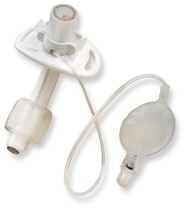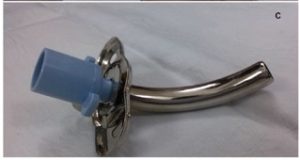When we call our colleagues from ENT with a question about a patient’s tracheostomy, they’ll want to know what type of tube the patient has. Let’s go over two types:
Plastic Tubes
Flexible plastic tubes (most common brand name is Shiley) are seen very commonly. They usually have an inner cannula and an outer cannula. The inner cannula can be removed for cleaning and suctioning. However, adding an inner cannula decreases the diameter of the stoma, and therefore increases work of breathing. These tubes are usually cuffed, like an adult ET tube. The cuff allows for positive pressure ventilation with PEEP, and for a better airway seal.
Some plastic tubes are fenestrated. When the inner cannula is removed from a fenestrated tracheostomy tube, the opening of the tube is occluded, and the cuff is deflated, a patient can speak.
Metal Tubes
Metal tubes (brand name Jackson) are seen less commonly, because of their rigid construction. They are usually made of stainless steel or sterling silver. Think of a metal tube as a “place-holder.” It will preserve the stoma, but it does not have a cuff, and it cannot be connected to a ventilator. If a patient requires mechanical ventilation, ENT will usually switch to a plastic tube. However, in an emergency where positive pressure ventilation must be initiated immediately, one journal article (Syed et al, see below) suggests removing the universal 15 mm connector from the end of a size 6 endotracheal tube, attaching it to the Jackson, and ventilating via BVM.
References:
- Long B, Koyfman A. Resuscitating the tracheostomy patient in the ED. Am J Emerg Med. 2016;34(6):1148-55.
- Syed KA, Paul RR, Varghese AM, Joseph NA. Emergency ventilation with a Chevalier Jackson’s metal tracheostomy tube. Int J Pediatr Otorhinolaryngol. 2014;78(5):888-90.
- Hess DR, Altobelli NP. Tracheostomy tubes. Respir Care. 2014;59(6):956-71.


